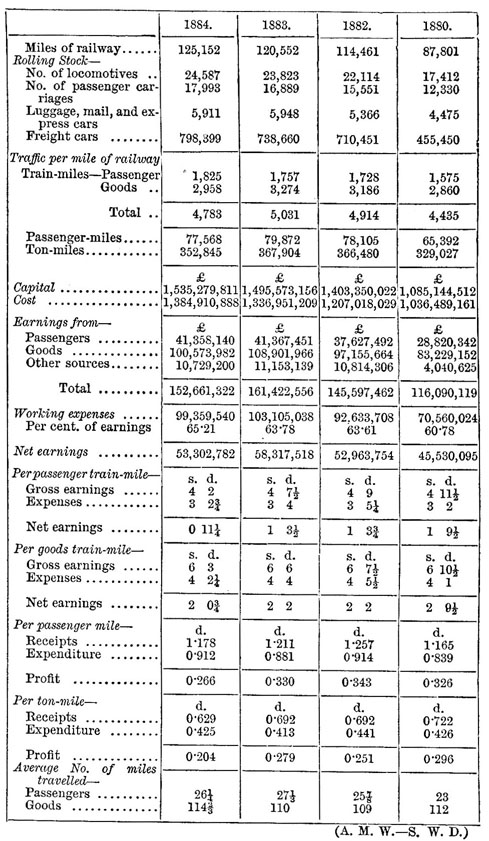K. RAILWAYS - FOREIGN AND CONTINENTAL (cont.)
Railways - United States - Working
Though American railways have steeper grades and sharper curves than in Europe, the loads carried in freight trains are sometimes exceptionally large; trains of 45 or 50 eight-wheeled cars each loaded with nearly 18 tons are common. The average load on the principal lines has been doubled since 1870, largely by the adoption of heavier and more powerful locomotives and by the better management of trains, and to some extent by a better condition of permanent way. This has had much to do with the great reduction in the rates charged. The cost of working American railways is usually a larger proportion of the earnings than in Europe. An American railway which spends 60, 66 2/3, or 75 per cent. of its earnings for working expenses would in England be called costly to work. The expense per ton per mile on several railways in recent years has been, in cents per ton of 2000 lb. (Table XXXIX.):—

The expense per passenger mile, which is larger than in Europe, since the traffic is nearly all first-class, is shown, in cents, in Table XL.:—

American railways also contrive to do their work with a very small number of men. In 1880 86,781 miles of railway were worked with a force of 418,957 men, or 4·7 men per mile, against 367, 793 in the United Kingdom on 18,681 miles, or 19·7 per mile, and 316,570 in Germany, or 14·3 per mile. The greater thinness of traffic on American lines accounts for but part of this, for the number of train-miles per year per man employed in different countries is 929 in the United States, 350 in the United Kingdom, 476 in Germany, 395 in Austria-Hungary. A better measure of the work done per man is the number of passenger and ton miles for each man employed (which cannot be given for the United Kingdom); this is shown in Table XLI.:—

The principal statistics of the railways of the United States in recent years are shown in Table XLII.:—

(A. M. W. — S. W. D.)
Read the rest of this article:
Railway, Railways - Table of Contents
The above article was written by:
-- [Parts 1-43] Daniel Kinnear Clarke, M.Inst.C.E.; author of Railway Machinery, An Elementary Treatise on Steam and the Steam Engine, Tramways: their Construction and Working, and other works on engineering.
-- [Parts 44-46] Arthur Twining Hadley, LL.D.; President of Yale University; joint editor of the New Volumes of the Encyclopaedia Britannica (i.e. 10th Edition); author of Railroad Transport, Economics, etc.
-- [Parts 47-53] (1) Arthur Mellen Wellington; author of The Computation of Earthwork from Diagrams, Location of Railways, Car-building Dictionary; chief engineer of the Toledo, Canada, Southern and Detroit Railway;
and (2) S. Wright Dunning, New York.



